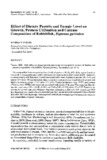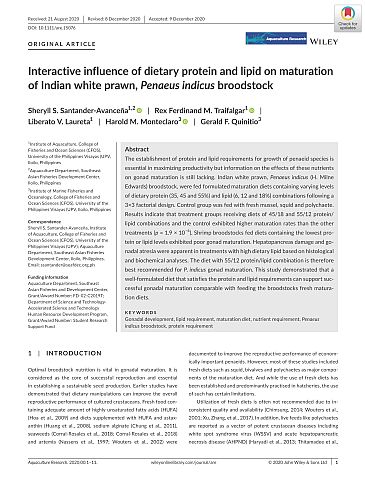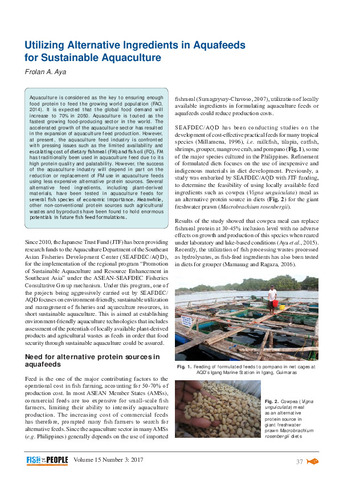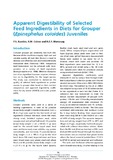Effect of dietary protein and energy level on growth, protein utilization and carcass composition of rabbitfish, Siganus guttatus

View/
Request this document
Date
1990Author
Page views
195Metadata
Show full item recordCited times in Scopus
Share
Abstract
Six semipurified diets comprising three levels of protein (25, 35, 45% of dry matter) each at two levels of estimated energy (3161, 3832 kcal/kg) were fed to fry for 8 weeks in 250-l tanks at a stocking density of 80 fish/tank. Growth increased with increasing dietary protein \((P\lt0.01)\) and energy \((P\lt0.05)\). Within isocaloric diets, a positive correlation was found between growth and dietary protein-to-energy \(\left(\frac{P}{E}\right)\) ratio \((P\lt0.05)\). Protein productive value (PPV) and protein efficiency ratio (PER) were negatively correlated with dietary \(\left(\frac{P}{E}\right)\) ratio. The equations describing this trend were: \(\mathsf{PPV}=50.16-0.19X\) and \(\mathsf{PER}=2.83-0.12X\), where \(X\) is \(\left(\frac{P}{E}\right)\). Based on responses for growth rate and efficiency of protein utilization, a diet with 35% protein and 3832 kcal/kg energy was found to be best for rabbitfish fry. Carcass fat levels increased in those fish fed diets with 3832 kcal/kg energy. Carcass protein and ash percentages remained essentially constant and independent of dietary treatment.
Suggested Citation
Parazo, M. M. (1990). Effect of dietary protein and energy level on growth, protein utilization and carcass composition of rabbitfish, Siganus guttatus. Aquaculture , 86(1), 41-49. https://doi.org/10.1016/0044-8486(90)90220-H
Subject
Collections
- AQD Journal Articles [1215]
Related items
Showing items related by title, author, creator and subject.
-
Interactive influence of dietary protein and lipid on maturation of Indian white prawn, Penaeus indicus broodstock
Santander-Avancena, Sheryll; Traifalgar, Rex Ferdinand; Laureta, Liberato V.; Monteclaro, Harold; Quinitio, Gerald (Wiley, 2021)The establishment of protein and lipid requirements for growth of penaeid species is essential in maximizing productivity but information on the effects of these nutrients on gonad maturation is still lacking. Indian white ... -
Utilizing alternative ingredients in aquafeeds for sustainable aquaculture
Aya, Frolan A. (Secretariat, Southeast Asian Fisheries Development Center, 2017)Aquaculture is considered as the key to ensuring enough food protein to feed the growing world population (FAO, 2014). It is expected that the global food demand will increase to 70% in 2050. Aquaculture is touted as the ... -
Apparent digestibility of selected feed ingredients in diets for grouper (Epinephelus coioides) juveniles
Eusebio, Perla S.; Coloso, Relicardo M.; Mamauag, Roger Edward P. (Australian Centre for International Agricultural Research, 2004)This study was conducted to determine the quality of selected feed ingredients as protein sources in grouper diets, based on their nutrient composition and apparent digestibility coefficients for dry matter (ADMD) and crude ...




